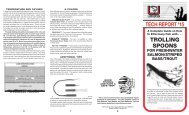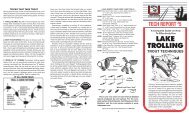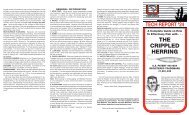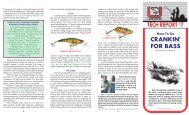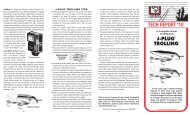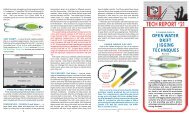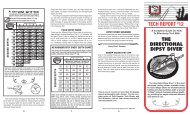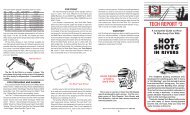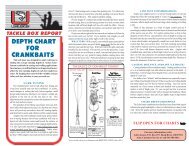11 Lake Trolling Thin-Blade - Let's Catch Fish
11 Lake Trolling Thin-Blade - Let's Catch Fish
11 Lake Trolling Thin-Blade - Let's Catch Fish
You also want an ePaper? Increase the reach of your titles
YUMPU automatically turns print PDFs into web optimized ePapers that Google loves.
wobbling action. On each outside turn the lure will rise<br />
and produce a faster wobble. With each turn you will<br />
generate different action from the spoon. It’s these<br />
changes that trigger strikes from nearby trout.<br />
In addition to these three basics of trolling strategy,<br />
another element to consider is that fish relate to shelter/cover/structure<br />
and will always be close to an area<br />
which can provide immediate escape from predators<br />
and direct sunlight.<br />
Locate food items in a lake and you will find concentrations<br />
of trout nearby. Surface activity of either feeding<br />
trout, bait fish or an insect hatch is an instant giveaway<br />
of where to fish. Highly-oxygenated water concentrates<br />
both food and fish. Most lakes stratify into three layers<br />
during early spring and stay that way until late fall with<br />
the middle layer of water, the thermocline, holding a<br />
high concentration of dissolved oxygen and forage fish.<br />
Other than those cases where there is obvious surface<br />
feeding activity, you should concentrate your fishing<br />
efforts in or near this thermocline layer (15 to 20 feet<br />
down in most medium-sized lakes).<br />
ADDING VARIETY<br />
Utilizing the same equipment and techniques outlined<br />
for thin-blade spoons, there are other lure types you can<br />
employ to add variety to your presentation. These include<br />
spoons of thicker profile and small swimming plugs.<br />
The Luhr-Jensen Krocodile ® and Hus-Lure due to<br />
the weight inherent to their thicker material, are most<br />
commonly associated with casting applications. But<br />
make no mistake, the slow wobble these spoons offer<br />
is just as productive in trolling as it is in cast-and-retrieve<br />
presentations. <strong>Fish</strong>ed on a comparable setup as<br />
a thin-blade spoon, the heavier Krocodile or Hus-Lure<br />
will achieve slightly greater depth. When fishing multiple<br />
rods from a boat, mixing a heavier spoon with a lighter<br />
one on another rod is a great technique for prospecting,<br />
as different depths are covered simultaneously.<br />
Small swimming plugs, like the #60 and #70 Hot<br />
Shot ® , along with K3, K4 and K5 Kwikfish ® , will fish at<br />
depths very similar to thin-blade spoons when fished<br />
on comparable gear. The plugs, however, bring a larger<br />
profile and distinct side-to-side action to the spread. With<br />
the keys to successful angling including both locating fish<br />
and delivering presentations that initiate strikes, these<br />
plugs are excellent tools to include in your lure selection.<br />
Like the Krocodile and Hus-Lure, the small plugs can<br />
be very effective when prospecting new water.<br />
TO RECAP<br />
• <strong>Trolling</strong> with small, lightweight, thin-blade spoons is a<br />
technique geared to ultra-light tackle and allows the<br />
angler the big advantage of using trolling techniques<br />
while still maintaining light lines, rods and reels. It is<br />
extremely effective in small or shallow lakes, when fish<br />
are feeding near the surface in larger lakes or when<br />
you wish to troll along shoreline areas.<br />
• Small, thin-blade spoons produce frantic, erratic action<br />
in the water when trolled in S-curve patterns and at<br />
varying speeds.<br />
• Line twist possibilities can be prevented by adding a<br />
swivel 36 inches up the line from the spoon.<br />
• When fish are active on the surface, trolling a thin-blade<br />
spoon without any additional weight will put your lure<br />
directly in the path of feeding trout.<br />
• Small split shot or a Troll Ease can be added 36 inches<br />
up the line to increase the trolling depth.<br />
• The thermocline layer of water (from 15 to 20 feet in most<br />
medium-sized lakes) harbors the majority of food and fish<br />
from spring through fall and trolling should be concentrated<br />
there, when trout are not active on the surface.<br />
• The angler who experiments with different lure patterns<br />
and colors will catch more fish and will find which<br />
patterns and colors work best, at what depth and at<br />
what time of the year on a given body of water.<br />
• Lead core trolling line provides an excellent way to get a<br />
thin-blade spoon deep without additional weights.<br />
• <strong>Thin</strong>-blade spoons can be worked effectively with fly<br />
rods and sinking fly lines with the line choice based<br />
on how deep you wish to troll.<br />
• Standard trolling practice with these spoons is to<br />
attach your leader or line to the attachment device<br />
provided with the lure, let out 100 feet of line behind<br />
your moving boat and begin to troll, making sure to<br />
vary the speed of the lure and depth constantly.<br />
• Heavier spoons and small plugs perform differently than<br />
thin-blade spoons. Mixing them into a trolling spread<br />
is an effective technique for prospecting water.<br />
GOOD FISHING<br />
& HAVE A<br />
SAFE TRIP!<br />
This is one of a series of more than 25 detailed<br />
reports produced by Luhr-Jensen. For the complete<br />
series of Tech Reports, Tech Sheets and<br />
Tech Bulletins, visit the Luhr-Jensen website at<br />
www.luhrjensen.com.<br />
TECH REPORT # <strong>11</strong><br />
A Complete Guide on<br />
LAKE TROLLING<br />
THIN-BLADE<br />
SPOONS<br />
FOR TROUT<br />
Of the many techniques used for catching<br />
trout, trolling with lake trolls trailed either<br />
by a lure or bait is the most consistent<br />
day-in and day-out fish producer. However,<br />
this method does not readily lend itself to<br />
light spinning or fly tackle, as a fully-rigged<br />
troll will overpower ultra-light gear. Nor is it<br />
applicable in shallow water situations. This<br />
Tech Report will provide you with information<br />
on how to troll effectively with light<br />
weight tackle and thin-blade spoons.<br />
6<br />
7<br />
Visit us on the web at www.luhrjensen.com #8822-0<strong>11</strong><br />
8<br />
© Luhr-Jensen of Hood River, Oregon<br />
<strong>11</strong> <strong>Thin</strong> <strong>Blade</strong> Final.indd 1 1/21/09 1:01:53 PM
Light tackle trolling of thin-blade spoons allow you to<br />
enjoy the effectiveness and productivity of trolling with<br />
an absolute minimum of gear while providing maximum<br />
sport from even small trout. It also allows you to effectively<br />
troll shorelines, weed beds and other areas<br />
too shallow for standard lake trolls.<br />
<strong>Trolling</strong> as an approach results in more and larger<br />
fish being consistently caught because an entire body<br />
of water or large section of a lake can be efficiently<br />
prospected and fish concentrations pinpointed with a<br />
minimum of effort.<br />
<strong>Trolling</strong> thin-blade spoons with light tackle is both<br />
easy and fun. Tackle consists of the rod and reel of your<br />
choice, either fly or spin, 4-lb. test monofilament line (15<br />
feet of 4-lb. test leader in the case of a fly outfit), a few<br />
split shot and assorted spoons. The big reason many<br />
anglers prefer this technique over other trolling methods<br />
is that it only requires a minimum of terminal gear.<br />
NOTE: When fishing very light tackle, it is important<br />
that you use a premium quality monofilament. Hard<br />
strikes will test your gear.<br />
<strong>Thin</strong>-blade spoons are most often from 1- to 2-inches<br />
in length and are manufactured from very light gauge<br />
metal. Extremely light in weight, they’re unsuitable for<br />
casting applications on their own, but for trolling their<br />
slim profiles produce vibrant action. Most come with a<br />
small single hook which adds both a swimming tail to<br />
the blade and ensures a solid hookup. Line attachment<br />
devices on thin-blade spoons will take the form of a<br />
split ring, welded ring or ring-and-swivel combination.<br />
In the case of the Super Duper ® , the attachment device<br />
is a lightweight wire snap. Because of the lightweight<br />
construction and delicate balance of these lures, you<br />
should not add other snaps or rings as this can destroy<br />
their action. Other popular thin-blade spoons include<br />
the Needlefish ® and Kokanee King .<br />
Nickel/Red Head, #0131 Brass/Red Head, #0188<br />
When using light tackle and 4- to 6-lb. test monofilament<br />
Needlefish ® line, all that’s required is to tie one of these spoons to the<br />
end of your leader or main line, let out 60- to 100-feet<br />
of line behind your moving boat and begin to troll. At<br />
a normal slow trolling speed, with plenty of “S” curves<br />
worked in, your spoon will run from 12- to 16-inches<br />
beneath the surface. To achieve deeper depths, split shot<br />
can be added ahead of the lure (about 36 inches).<br />
Everglo /Fluorescent Green Stripe, #0314 Rainbow<br />
Trout/Nickel Back and #0083 Pearl Bikini. The some<br />
of the Super Duper colors are #0074 Frog/Brass Back,<br />
#0130 Nickel/Red Head, #0131 Brass/Red Head, and<br />
#0314 Rainbow Trout. For the Kokanee King try the<br />
#0130 Nickel/Red Head, #0133 Pearl/Red Head or<br />
#0131 Brass/Red Head.<br />
Obviously, trolling thin-blade spoons will produce the<br />
best results when fish are shallow. On smaller bodies of<br />
water without great depth, this may be all season long.<br />
On larger, deep lakes, trout are most commonly shallow<br />
in early spring. Coming out of a cold winter surface<br />
waters are the first to warm, congregating early insect<br />
Super Duper ®<br />
hatches, bait fish and trout high in the water column.<br />
During this period you’ll find fish in open water, as<br />
well as relating to structure and food sources. Shallow<br />
weed beds and ledges are always hot areas of activity<br />
providing a source of food for foraging fish throughout<br />
the seasons. As summer wears on activity in these near<br />
Depending on the depth you wish to reach, fly lines<br />
can be floating, sinking or sink tips. The 10- and 15-foot<br />
sink tip models lend themselves very well to thin-blade<br />
Regardless of the trolling method you choose, whether<br />
it includes a lake troll or not, here are several suggestions<br />
which will help you regularly catch more and<br />
larger trout:<br />
shore areas will gravitate towards cooler morning and spoon trolling in deeper lakes as they will position your<br />
1. TROLL SLOWLY Large fish will not spend any more<br />
evening periods.<br />
lure right above or in the thermocline. Deep trolling with<br />
energy than they absolutely have to in catching a meal.<br />
a thin-blade spoon and fly line is possible with a fastsink<br />
or 30-ft. sink tip line. Once you have chosen the<br />
Most spoons will not perform correctly at a fast speed<br />
because it causes them to spin in the water, create line<br />
line, based on the depth you wish to fish, tie the spoon<br />
twist and lose their fish-enticing wobble and vibrations<br />
to the end of your leader, strip out 40 to 60 feet of fly<br />
pattern. The best advice is to troll slowly, the slower<br />
line and begin to troll.<br />
the better.<br />
Troll Ease <br />
Another variation for trolling thin-blades deep without<br />
using heavy leads or large trolls, is lead core line. Lead 2. VARY YOUR SPEED While slow is the key word in<br />
core is color-coded in 25-ft. sections and anglers often successful trolling, this does not mean slow all the time.<br />
refer to distances in terms of how many colors they have A spoon running through the water at a constant speed,<br />
out. For example “three colors” would translate to 75 constant depth and giving off the same vibration pattern<br />
feet of lead core plus whatever leader length was used. will not catch many fish as there’s just nothing there to<br />
Because thin-blade spoons do occasionally turn over Lead core line does require the use of a large capacity indicate to a predator that an easy meal is available or<br />
in the water, regardless of speed, some line twist will fly reel or casting reel due to its bulk.<br />
that something’s in trouble. Alter your speed every few<br />
occur. This can be prevented by tying a barrel swivel,<br />
Colors and finishes on thin-blades spoons are practically<br />
unlimited with many anglers developing their own vibration<br />
minutes to disrupt the spoon’s constant speed and<br />
preferably ball-bearing, roughly 36-inches from the lure<br />
pattern.<br />
and adding split shot as needed ABOVE the swivel. A<br />
Troll Ease is another device that can be used as a line<br />
twist preventing rudder when hollow lead weights are<br />
needed to troll a thin-blade spoon at deeper depths.<br />
For fishing thin-blade spoons on a fly rod, use 15 to<br />
20 feet of 4-lb. test leader, utilizing a nail knot to attach<br />
the leader to your fly line as illustrated.<br />
favorites for particular waters. Each small spoon has its<br />
own action and vibration pattern in the water. Having<br />
several different models and colors available will allow you<br />
to fit the lure to the fish’s preference on a given day.<br />
Of the many color patterns available, the following<br />
are proven producers and are solid starting points.<br />
For the Needlefish try #0074 Frog/Brass Back, #0130<br />
4 5<br />
3. WORK IN “S” CURVES Optimum trolling results<br />
require that you do everything possible to keep from<br />
running in a straight line. Working between two points<br />
in a “S” pattern, whereby the boat is always on a turn,<br />
will provide the maximum number of strikes and fish.<br />
Every time the spoon is on an inside swing of the boat,<br />
it will drop deeper in the water and produce a slower<br />
2<br />
3<br />
<strong>11</strong> <strong>Thin</strong> <strong>Blade</strong> Final.indd 2 1/21/09 1:01:53 PM



